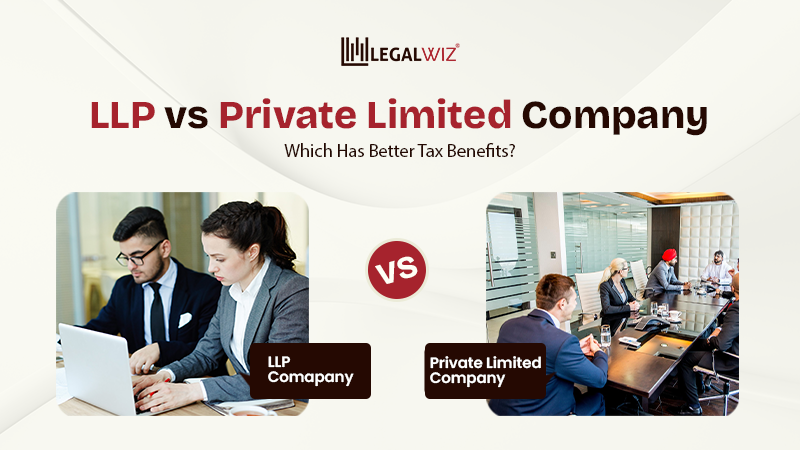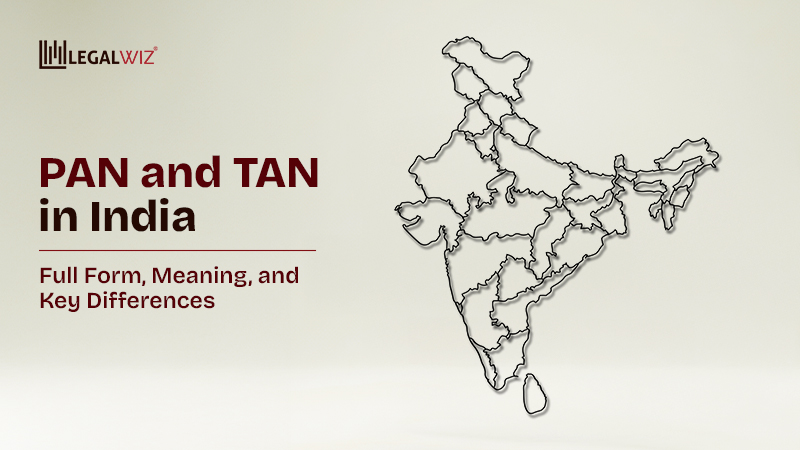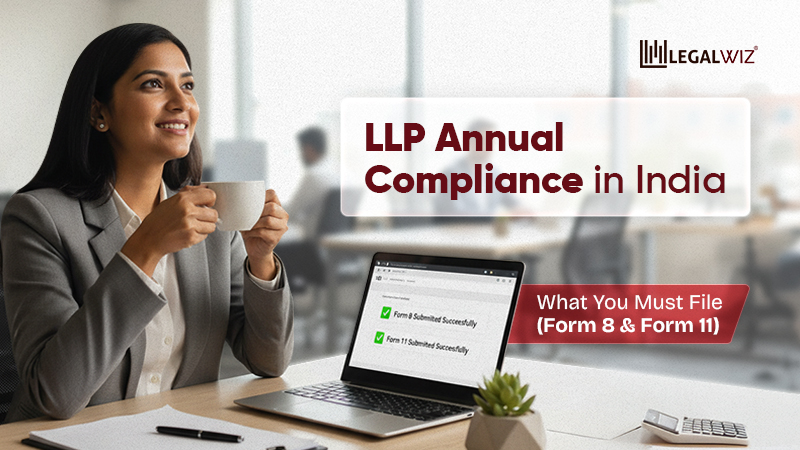LLP vs Private Limited Company: Which Has Better Tax Benefits?
Choosing the right business structure affects how your company runs, how much tax you pay, and how much profit you keep. Whether you register as a Limited Liability Partnership (LLP) or a Private Limited Company, the tax treatment, compliance obligations, and withdrawal of profits all work differently.
Many new entrepreneurs today prefer Private Limited Company registration for its credibility and growth potential, while others choose LLPs for their flexibility.
In this blog, we’ll compare the taxation of LLP vs Pvt Ltd Companies in India, breaking down how each structure affects your overall tax burden.
The aim is to help entrepreneurs and business owners make a practical, financially sound, and compliant choice that best suits their long-term business goals.
Basic Difference Between LLP and Pvt. Ltd.
Before we compare taxes, it helps to understand how LLPs and Private Limited Companies differ at a basic level.
| Aspect | LLP (Limited Liability Partnership) | Private Limited Company |
| Legal Identity | Separate legal entity formed under the LLP Act, 2008. Partners act as agents of the LLP, not of each other | Separate legal entity under the Companies Act, 2013. Shareholders and directors are distinct from the company. |
| Ownership & Management | Owned and managed by partners as per the LLP Agreement. Each partner’s role and profit share are defined contractually | Owned by shareholders and managed by directors. Decisions follow company law and board resolutions. |
| Profit Distribution | Profits are shared among partners and taxed at the LLP level only—no additional tax on withdrawals | Profits are first taxed at the company level; dividends distributed to shareholders are taxed again in their hands. |
| Compliance Requirements | Comparatively simpler. Annual Statement of Accounts and LLP Form 11 filing required | Stricter. Must file annual returns, conduct statutory audits, and maintain detailed records with the MCA. |
| Registration & Maintenance Cost | Lower setup and compliance costs | Higher registration fees and ongoing compliance expenses. |
For a more detailed comparison of features, registration process, and compliance differences between the two structures, refer to our in-depth blog on the difference between LLP and Pvt Ltd Company in India. It explains how each model functions in practice and helps you identify which structure suits your business goals.
Taxation of LLP in India
Taxation is one of the key advantages of choosing a Limited Liability Partnership (LLP). Here’s how LLPs are taxed under Indian law:
You can also read our detailed guide on what is Limited Liability Partnership is to learn how LLPs work, their advantages, and when they might be a better fit for your business.
Flat Tax Rate
LLPs are taxed at a flat rate of 30% on their total profits. Unlike private limited companies, LLPs do not get lower tax rates based on turnover.
To understand how LLPs are taxed and the implications for your business, read our guide on taxation for Limited Liability Partnerships.
No Dividend Distribution Tax
One of the biggest benefits is that Partners in LLP can withdraw profits without paying any additional tax.
Tax is charged only at the LLP level, so there is no double taxation.
Surcharge and Cess
- A 12% surcharge is levied when the total income exceeds ₹1 crore
- 4% Health and Education Cess is charged on the total tax plus surcharge
Loss Carry-Forward
LLPs can carry forward business losses for future set-off, provided:
- The income tax return is filed on time, and
- The partners remain the same (continuity condition).
Note: Unlike individual professionals or partnership businesses, LLPs cannot be taxed on a presumptive basis under Sections 44AD or 44ADA.
For a clear breakdown of the presumptive taxation benefits, from lower compliance to simpler filing, check out the article before making your move.
AMT (Alternate Minimum Tax)
AMT applies at 18.5% of adjusted total income, plus surcharge and cess, when they claim deductions under Chapter VI-A (except Section 80P) or Section 10AA. This ensures LLPs also maintain a minimum tax liability in such cases; for more details, check our guide on AMT for LLP.
Example: Tax on ₹50 Lakh Profit
- Income tax @ 30% = ₹15,00,000
- Cess @ 4% = ₹60,000
- Total tax liability ≈ ₹15,60,000
- Net profit available for partners = ₹34,40,000 (with no extra tax on withdrawal)
This shows why LLPs are often preferred for businesses looking to avoid double taxation.
Taxation of a Private Limited Company
Private Limited Companies are taxed differently from LLPs and face an additional layer of taxation when profits are distributed. For details on applicable tax slabs and rates, check out our guide on private limited company tax rates.
If you’re new to company formation, start by reading our guide on what is Private Limited Company is to understand its structure, benefits, and registration process before exploring how it compares with LLP taxation.
Corporate Tax Rates
Companies are taxed based on their turnover:
- 25% tax rate if the company’s turnover in the previous year was up to ₹400 crore
- 30% tax rate if turnover exceeded ₹400 crore
Note:
Section 115BAA of the Income Tax Act allows domestic enterprises to pay tax at 22% (plus 10% surcharge and 4% health and education cess) regardless of turnover if they do not claim deductions or incentives. Companies seeking simple taxes without exemptions may choose this optional regime, which has an effective tax rate of 25.17%.
Additional Taxes: Surcharge & Cess
Along with the base tax:
- A 7% surcharge applies if income is above ₹1 crore but up to ₹10 crore, and 12% if income exceeds ₹10 crore
- 4% Health and Education Cess is levied on tax plus surcharge
Dividend Taxation and Double-Tax Impact (Double Taxation)
Companies no longer pay Dividend Distribution Tax (DDT).
However, when profits are distributed, shareholders must pay tax on dividends according to their income tax slab.
This leads to double taxation:
- At the company level (corporate tax)
- At the shareholder level (dividend tax)
MAT (Minimum Alternate Tax)
If a company reduces its taxable income due to deductions or exemptions, MAT @ 15% (plus surcharge and cess) may apply.
This ensures companies pay a minimum amount of tax.
To learn how Minimum Alternate Tax (MAT) and Alternate Minimum Tax (AMT) differ and how they apply to various businesses, check out our guide on the difference between MAT and AMT.
Example: Total Tax Outflow on ₹50 Lakh Profit
- Corporate tax @ 25% = ₹12,50,000
- Cess @ 4% = ₹50,000
- Total tax ≈ ₹13,00,000
- Remaining profit = ₹37,00,000
If the company distributes this amount as dividends:
- A shareholder in the 30% tax slab pays approximately ₹11,10,000 as dividend tax (Assuming the shareholder falls under the 30% slab without exemptions)
So, the total tax outflow becomes much higher compared to an LLP.
Note: The actual tax on dividends varies according to the individual shareholder’s income tax slab and provisions under Sections 115A and 115BBDA, not a fixed rate.
Key Tax Differences – LLP vs Pvt. Ltd. Companies
| Particulars | LLP | Private Limited Company |
| Tax Rate | 30% (flat rate) | 25% (for turnover up to ₹400 crore) or 30% (for turnover above ₹400 crore); optional 22% concessional rate available under Section 115BAA |
| Dividend Tax | Not applicable; profit share is tax-free for partners | Dividend is taxable in the hands of shareholders |
| MAT/AMT | AMT @18.5% applies if LLP claims deductions under Chapter VI-A (except 80P) or Section 10AA | MAT is applied at 15% of book profits (plus surcharge & cess) |
| Audit Requirement | Mandatory only if turnover exceeds ₹40 lakh or contribution exceeds ₹25 lakh | Statutory audit for all companies and Tax audit u/s 44AB only if turnover exceeds ₹1 crore (₹10 crore for digital transactions) |
| Profit Withdrawal | Tax-free for partners | Treated as dividend; taxable |
| Compliance Cost | Lower compliance and maintenance cost | Higher compliance, more filings, and increased cost |
For businesses and professionals, understanding income tax audit requirements is crucial to staying compliant. You can read our detailed guide on Income Tax Audit u/s 44AB to know the limits, due dates, and penalties for AY 2025‑26.
Which Structure Offers Better Tax Advantage?
Choosing between an LLP and a Private Limited Company depends largely on your tax priorities and long-term business plans.
When an LLP Offers Better Tax Benefits
An LLP is generally more tax-efficient for:
- Smaller or service-based businesses that want simple, predictable taxation
- Partners who wish to withdraw profits freely, without paying additional tax
- Businesses that do not require equity funding or venture capital investment
- Firms looking for lower compliance costs and reduced annual paperwork
LLPs avoid double taxation, making them ideal for owners who prefer taking home profits regularly.
When a Private Limited Company Is More Advantageous
A Private Limited Company works better for businesses that aim for:
- High scalability and rapid growth
- External investors, VC funding, or equity-based expansion
- Long-term reinvestment of profits into the business
- Access to lower tax rates (25%), depending on turnover
Companies gain reputation, finance, and organized governance despite dividend taxes increasing tax outflow.
Note: LLPs must get clearance for foreign investment; however, Private Limited Companies may receive FDI automatically in most areas. Companies get an advantage in investor recruitment and worldwide expansion.
Final Consideration
Before choosing your business structure, evaluate:
- Total tax outflow
- Compliance obligations
- Fundraising needs
- Long-term business goals
The right choice balances both tax efficiency and your future growth plans.
Expert Insight: Practical Scenario
To understand the real tax impact, let’s look at a simple example.
Assume both an LLP and a Pvt Ltd company earn ₹50 lakh profit in a financial year.
LLP – Total Tax Outflow
- Tax @ 30% = ₹15,00,000
- Cess @ 4% = ₹60,000
- Total tax = ₹15,60,000
- Take-home profit for partners = ₹34,40,000
- No additional tax on withdrawals
Result: Partners keep the entire post-tax profit.
Private Limited Company – Total Tax Outflow
- Corporate tax @ 25% = ₹12,50,000
- Cess @ 4% = ₹50,000
- Total corporate tax = ₹13,00,000
- Profit left = ₹37,00,000
If the company distributes this as a dividend:
- Shareholder in 30% tax slab pays approx. ₹11,10,000 tax on dividends
- Total tax outflow = ₹24,10,000
- Take-home income = ₹25,90,000
Result: Dividend taxation sharply reduces actual take-home income.
Key Insight
Even though a Pvt. Ltd. enjoys a lower base tax rate, the second layer of tax on dividends significantly increases the total tax outflow—making LLPs more tax-efficient when owners regularly withdraw profits.
Conclusion
Both LLPs and Private Limited Companies offer meaningful tax advantages, but the ideal choice depends on your business goals.
- LLPs are more tax-efficient when partners prefer profit withdrawals and want to avoid double taxation.
- Private Limited Companies benefit from lower base tax rates and are better for businesses planning long-term reinvestment, growth, or fundraising, even though dividend taxation increases overall outflow.
Tax savings are crucial, but you should also consider compliance capability, operational objectives, scalability, and long-term strategy before choosing a structure. For personalized guidance and company registration, you should connect with the experts. LegalWiz.in can assist you in picking a company structure that optimizes tax planning.
Frequently Asked Questions
Which pays less tax - LLP or Private Limited Company?
An LLP usually pays less tax overall. It’s taxed only once on total profits, and partners don’t pay extra tax when taking money home. A Private Limited Company is taxed twice — first on profits, and again when shareholders get dividends.
Do companies have lower tax rates than LLPs?
Yes, but only up to a point. Companies with turnover below ₹400 crore pay 25% tax, while LLPs pay 30%. Still, once dividend tax is added, the total tax for a company often ends up higher.
When is an LLP better for tax savings?
An LLP works best for small or service-based businesses that want simple rules and fewer filings. It’s also good for partners who want to withdraw profits freely without paying more tax.
When is a Private Limited Company the better choice?
A Private Limited Company is better if you plan to grow fast, raise funds, or reinvest profits. Even with higher tax costs, it offers more trust, better funding options, and easier expansion.

Sapna Mane
Sapna Mane is a skilled content writer at LegalWiz.in with years of cross-industry experience and a flair for turning legal, tax, and compliance chaos into clear, scroll-stopping content. She makes sense of India’s ever-changing rules—so you don’t have to Google everything twice.







